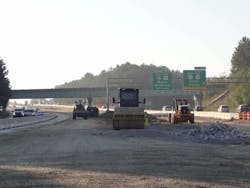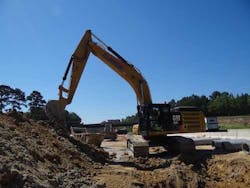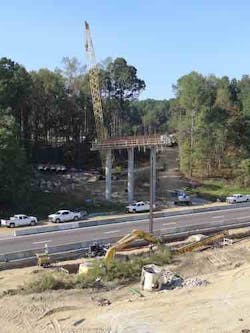Road and bridge redesign on I-40 in Raleigh, N.C., addresses present congestion and future travel needs
Excitement is buzzing in the “City of Oaks” and its surrounding communities with so much commercial and residential development. However, growth does not come without its challenges, and like many other cities on the rise, sometimes it’s on the road where that is most obvious.
One of Raleigh’s most high-volume areas of traffic is situated on a stretch of I-40 where it breaks off from the I-440 beltline heading towards the suburbs of Johnston County. Traffic congestion and delays are common in the area, especially in the morning and afternoon rush hours. With steady growth expected to continue in the region, the North Carolina DOT (NCDOT) understood that these conditions would only worsen.
“We knew that we needed to make some changes to get ahead of the curve,” said Boyd Tharrington, division construction engineer at NCDOT. “Making improvements now will help alleviate some current traffic congestion and prepare us for the road ahead.”
As it set out to improve I-40 and plan for the future, the NCDOT understood that it would need to build a solid strategy with an experienced contractor ready to tackle the elements in design, and traffic management that come with a large project.
Building an action plan
In 2018, NCDOT set out on a major widening and redesign effort to improve existing traffic in the heavily traveled area of I-40 and accommodate future growth. The project covers nearly 13 miles of the highway extending from the I-440 divide in Raleigh to two miles east of the busy NC 42 interchange in Johnston County. Originally split into two separate projects—one for widening from I-440 to Swift Creek at the Johnston County line, and another for interchange upgrades at both NC 42 and Cleveland Road—NCDOT found a way to merge them working with S.T. Wooten as the lead contractor.
“We felt that time was of the essence on these initiatives,” said Tharrington. “By combining various activities within one project, we’ll be able to manage progress more efficiently and get certain sections completed faster to benefit the public.”
S.T. Wooten Project Manager Matt Davis says everyone involved in the project has been in close contact since the beginning.
“Our project leaders often meet with NCDOT, but we’ve also taken things up a notch in terms of our internal meetings due to the scope,” said Davis. “Managers from every division in our company got together to review every step of the project before we started.”
As part of its technical proposal, S.T. Wooten’s design-build team set an intermediate deadline of December 2021 for the troublesome section from the I-440 split to the U.S. 70 Bypass. The full project will wrap up in the summer of 2022.
Challenge accepted
For the I-40 expansion, S.T. Wooten will add two new lanes in each direction of the highway—extending four-lane sections to eight lanes and six-lane sections to 10 lanes. Work will also involve adding 9.5 in. of asphalt overlay to the existing lanes.
One of the biggest obstacles anticipated with the I-40 job is the traffic volume within the work zone. The project has several hauling and lane closure restrictions that require some operations to be done at night during limited hours. To help manage things, S.T. Wooten established six separate work zones where construction is happening simultaneously in different sections.
“Workflow varies depending on each individual section,” said Davis. “For example, in one area, we’re building the inside lanes first. Then we’ll put traffic on the new inside lanes and build the outside lanes. But in other areas we’re constructing the outside lanes first, then building the inside.”
Having each work zone mapped out, Davis and his team can keep a line of sight on all the work happening and adjust if an unforeseen event occurs.
“Utility or right-of-way issues can sometimes throw a wrench into your plans,” said Davis. “By understanding how each section fits together, we can communicate better with each other and prioritize work if needed to keep everything running on schedule.”
Bridges and diamonds
Along with the lane extensions, S.T. Wooten will manage the construction of 15 bridges along I-40 as part of the design-build project. One notable structure is a new flyover bridge coming from I-440 westbound to I-40 eastbound. The bridge has six spans, four of which have concrete girders.
At the I-40 interchange with N.C. 42, a busy hot spot for traffic, crews will reconstruct the entire interchange, converting it into a diverging diamond interchange (DDI) with dual bridges. This DDI will allow two directions of traffic guided by traffic signals, pavement markings, and concrete barriers to cross over each other at traffic signals to get onto the interstate safely and quickly.
“It’s a pretty new concept in North Carolina, but it has proven effective in its ability to let drivers come through an intersection more smoothly,” said Tharrington. “It may appear a little different for drivers at first, but we expect this update to alleviate some of the traffic congestion that currently exists at the interchange.”
This will be the second DDI that S.T. Wooten has worked on, having previously helped build the state’s second-ever DDI to help alleviate some traffic congestion near the coast of North Carolina.
Crossing T’s on traffic management
With up to 100,000 cars expected to pass through the I-40 project each day, NCDOT and S.T. Wooten are applying a variety of techniques to ensure safety and efficiency. Intermittent speed limit reductions will be used in portions of the work zone where crews may be working. The speed limit will be reduced to 65 mph in these areas, indicated by electronic-display speed limit signs. Additionally, S.T. Wooten will be installing construction entrances and warning systems from the median to improve construction traffic flow.
“We’re taking a lot of precautions to secure the work zone for travelers and construction crews,” said Tharrington. “We want to keep traffic flowing smoothly through the work zone and also make sure that everyone stays safe.”
During the proposal and bid phase, S.T. Wooten proposed using a smart work zone system to help monitor traffic flow and divert motorists when there are heavy traffic backups or accidents. This system utilizes a series of sensors and message boards strategically placed throughout the area to more accurately detect travel times and provide alternative routes for drivers, if needed. Should an emergency arise, signs are in place onsite to help direct motorists through the alternate routes. Details on traffic issues and conditions are also routed to the NCDOT Statewide Operations Center where they can be distributed and shared with the public.
The long (or short) haul
Amid all the hustle and bustle, S.T. Wooten has a few tricks up its sleeve to increase efficiency when it comes time for delivery of materials. For one, most of the hauling and lane closures will take place at night to avoid run-ins with heavy traffic. Crews are also taking some unique measures with equipment to avoid hauling major loads on the highway.
“We constructed a temporary access ramp that will run from a closed highway bridge right down into the median,” said Davis. “Paired with this, we’ve installed a new asphalt plant right beside the project in the town of Garner. We’ll also be using a materials conveyer that will allow us to bypass traffic and deliver asphalt and stone directly to the site from our plant.”
The temporary access ramp will ultimately save 34,500 loads from being hauled in traffic, and the conveyor is expected to keep an additional 7,600 loads off the road. Temporary access ramps will also be utilized to gain access to the outside areas.
Today and looking ahead
When the I-40 project kicked off, there were several delays attributed to bad weather and cold temperatures. However, getting an early start on planning and pre-paving activities has helped teams stay on schedule.
“Working with NCDOT, we’ve been able lot get a lot of non-jurisdictional work done as we await some final working permits,” said Davis. “Clearing the median and completing grading work first puts us in a good position to activate quickly as the new year begins.”
If you drove through the job right now, you would see that crews have completed asphalt overlay throughout the entire project. The entire portable barrier wall has been installed as well. Looking to springtime of this year, the team hopes to begin making major headway on paving and have two to three bridges completed.
By the time all is said and done, the I-40 job will include more than 250 construction crew members working alongside those of the 20+ subcontractors on the project. “Development is the name of the game right now in Raleigh,” said Tharrington. “This project will be a team effort for everyone until we see the finish line, but it’s one we can all be proud of for the positive impact it has for the community.


